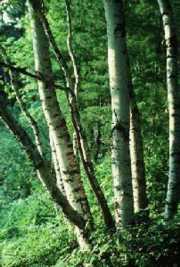

Common Names: Canoe
Birch, Silver Birch, Paper Birch
Genus: Betula
Species: papyrifera
Parts Used: leaves, sap, lumber,

The White Birch is a small to medium sized deciduous tree which grows to 70 or 80 feet in height. As far as trees go it doesn't live very long, only about 140 years. Small hear-shaped leaves are found at the ends of drooping twigs and branches. The paper birch has both male and female flowers called catkins. These turn into little winged nutkins, which ripen in early August to mid September. The wings help the seeds to fly away from the parent tree so there won't be competition for food and water.
You can identify this tree by its white bark which peels easily and is marked by narrow horizontal stripes. White birch trees can either have one slender stem or several stems. Moose like to browse on the young trees and will eat off the tops. This forces the tree to send up more stems.
The paper birch doesn't like shade and is the first tree to grow back in places that have had a fire or where trees have been cut.
Although moose and white-tailed deer will eat the leaves and tender shoots of the paper birch, it isn't their favorite food. Porcupines like to eat the bark and rabbits will eat the seedlings and young saplings. Yellow-bellied sapsuckers will peck little holes in the bark and feed on the sap. Hummingbirds and squirrels also drink the sap from the sap wells the sapsuckers made.
The bark is often used as a fire starter because it burns even when its wet. Native Americans also used the bark to cover their canoes. They also used it to make baskets, baby carriers, mats, torches and moose calls. Because the wood was strong and flexible it was made into spears, bows and arrows, snowshoes and sleds. The wood is now used for building lumber to make veneer, pulpwood and plywood. Syrup, wine, beer, and medicinal tonics are made from the sap.
The white birch is found in Newfoundland, Labrador, Canada, and from New England to North Carolina in the United States. It prefers colder climates, however.
2000.
Bibliography:
Petrides, George A. (1972). A Field Guide to Trees and Shrubs. Boston, MA, Houghton Mifflin Company.
"Paper Birch", http://www.rook.org/earl/bwca/nature/trees/betulapap.html